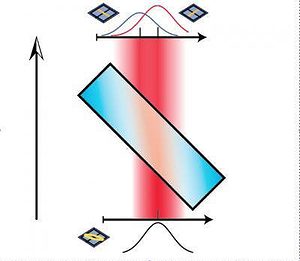
As light goes through a birefringent crystal the horizontally and vertically polarized components of light spread out in space, but an overlap between the two components remains when they emerge. In a strong measurement the two components would be fully separated. (c) Jonathan Leach
A group of researchers at University of Rochester and the University of Ottawa have found a way to bypass Heisenberg’s famous Uncertainty Principle, and measure key quantum properties directly for the first time like the polarization states of light. The technique might provide valuable in encoding qubits, the building blocks of quantum information theory.
Heisenberg’s Uncertainty Principle states that when certain properties of a quantum system are known precisely, others are known poorly. This is why a lot of scientists were until recently led to believe that fully understanding a quantum system is impossible.
The researchers challenge this idea, after they developed a nifty technique that relies on a “trick” to measure the first property of a system, leaving the remaining parties untouched, bypassing the uncertainty principle in the process. Developed in 2011, the technique allowed the researchers to directly measure the polarization states of light – the directions in which the electric and magnetic fields of the light oscillate. This proves that key variables, known as “conjugate” variables, of a quantum particle or state can be measured directly, contrary to popular belief.
“The ability to perform direct measurement of the quantum wavefunction has important future implications for quantum information science,” explained Robert Boyd, Canada Excellence Research Chair in Quantum Nonlinear Optics at the University of Ottawa and Professor of Optics and Physics at the University of Rochester. “Ongoing work in our group involves applying this technique to other systems, for example, measuring the form of a “mixed” (as opposed to a pure) quantum state.”
To measure the polarization states of light, the researchers performed “weak measurements” of the first property, and “strong measurements” of the second property in order to not disturb the quantum system. To this end, the scientists employed variable thickness birefringent crystals. In their experiments, Boyd and colleagues passed polarized light through two crystals of differing thicknesses: the first, a very thin crystal that “weakly” measures the horizontal and vertical polarization state; the second a much thicker crystal that “strongly” measures the diagonal and anti-diagonal polarization state. Since the first measurement didn’t disturb the system, the second reading was also viable.
Previously, scientists had managed to determine quantum states indirectly using a technique called quantum tomography. However, this entails a number of hassles like complex post-processing computations that require a significant amount of time to complete. This latest direct measurement technique renders the same results, with much less time required. The new technique could play a major role in the future of quantum computers.
“These results are the first direct measurements that are applicable to qubits — the fundamental unit of quantum information,” the authors write.
The findings were reported in a paper published in the journal Nature Photonics.









